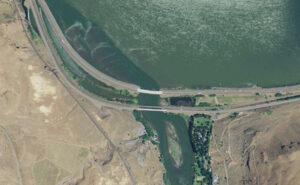Few tasks are as challenging as conserving endangered or threatened species. Such conservation often requires balancing many diverse and competing factors to preserve the species and their habitat while also allowing for the appropriate use of natural resources. John Palmer is part of a team at the region 10 office of the U.S. Environmental Protection Agency (EPA) that is working to achieve such a balance on the Columbia River by finding ways to preserve the cold water refuges that are important to migratory fish while ensuring dam operators and irrigators can still operate as well. In this interview, Mr. Palmer tells Hydro Leader about the EPA’s efforts, why cold water refuges are so vital for the future of salmon and other fish, and the role of collaboration with dam operators in conservation.
Hydro Leader: Please tell us about your background and how you came to be in your current position.
John Palmer: I’m a senior policy advisor for the water division at the EPA region 10 office in Seattle. I’ve been here for a little over 20 years. I work to ensure that our programs comply with the Endangered Species Act (ESA), and I work on a variety of special projects within the office.
Hydro Leader: Tell us about cold water refuges on the Columbia River and how they help migratory fish.
John Palmer: Cold water refuges are areas of water that are colder than the mainstem river—the Columbia, in this case. We generally find that where cold tributaries come into the Columbia River, there are areas of cooler water in which migrating fish can hold out in to avoid the warmer water of the mainstem.
Where a tributary comes into the river, it creates a plume of cold water. The fish use the plume and the lower mile or so of the tributary itself as a refuge. The Columbia is hottest from mid-July to mid-September. When the river’s temperature exceeds 20°C (68°F), salmon and steelhead start using these refuges. The main fish that use these refuges are steelhead, which migrate up the Columbia River during the peak temperatures in the summer, and fall Chinook, which are Chinook salmon that start migrating up the Columbia River in August.
We started this project because of the State of Oregon’s water quality standard, which stipulated that the Columbia River needed to have a sufficient number of cool water refuges distributed along the river to allow salmon and steelhead to migrate up the river as adults. We developed this plan to implement that standard. One of the things that we’ve learned is that the Columbia River is warming over time. Over the last 60–80 years, the river has warmed, in part due to climate change and in part due to the building of dams, which create reservoirs that absorb heat. Due to the warming of the river, we’re seeing fish using these refuges more and more to escape the warmer summer temperatures.
Hydro Leader: By how much has the river warmed?
John Palmer: We estimate that the August mean temperature of the river has increased by about 2½°C (4½°F).
Hydro Leader: How do dams and reservoirs contribute to that warming?
John Palmer: An impounded reservoir increases the area of the river that’s exposed to solar radiation and warm air. Impounded reservoirs also lengthen the residence time of the water in the river—in other words, they slow the river. When a broader area is exposed and the river is moving at a slower speed, it allows the heat of the water body to increase.
Hydro Leader: Would you tell us about the EPA’s cold water refuge plan?
John Palmer: The plan started because of an ESA consultation that we did on our approval of Oregon’s water quality standards. The National Marine Fisheries Service (NMFS) determined that our approval of Oregon’s standards would jeopardize ESA-listed species. While Oregon had a standard on the books called the cold water refuge standard, there was evidence that it wasn’t being implemented. In its biological opinion, the NMFS recommended developing this plan as a way to avoid jeopardizing the ESA-listed fish.
The plan itself sets out to do a number of things. First, it identifies, maps, and quantifies the cold water refuges from the mouth of the Columbia River on the Pacific Ocean all the way to the mouth of the Snake River, which is a little over 300 miles upriver. Second, it describes how and to what extent salmon and steelhead use those refuges. Third, it aims to determine whether the current number of refuges meets Oregon’s standards, and if not, to describe what actions are needed to meet Oregon’s standards. Fourth, it identifies actions to protect and restore cold water refuges and to create more refuges in the future. The final goal is to recommend the monitoring and future studies needed to address uncertainties.
Hydro Leader: How many cold water refuges exist today, and how should they be maintained and restored?
John Palmer: The plan identifies a total of 23 cold water refuges created by the 23 tributaries that provide cold water from the mouth of the Columbia up to the Snake River. Of those 23, 12 were defined as primary, because they represented the vast majority of the volume of the cold water refuges—about 98 percent. We concluded that in order to meet Oregon’s standards, we need to maintain those 12 tributaries and maintain the volume of cold water they add to the Columbia River. In addition, we concluded that we needed to cool the Umatilla River so that it provides more cold water.
Hydro Leader: Are you aware of any mitigation efforts that dam owners and operators have carried out to try to control the temperature of their reservoirs or the river downstream?
John Palmer: The most common way in which reservoir operators try to control the temperature of the river is by releasing water from deep in the reservoir. That can be done at storage dams whose reservoirs are stratified by temperature—in other words, where there is cooler water at the bottom of the reservoir and warm water at the surface. Four tributaries that provide cold water refuges to the lower Columbia River have dams upstream that release cool subsurface water that keeps the tributaries cool. Those four tributaries are the Cowlitz and Lewis Rivers in Washington and the Sandy and Deschutes Rivers in Oregon. The dams on the lower Columbia River mainstem are generally not storage dams. They pass water rather than storing it for months, and only in the latter case do you get that stratification.
Hydro Leader: Recognizing that your plan doesn’t prescribe any changes of this type, would you tell us whether there are any changes in hydropower dam operations or facilities that would benefit cold water refuges?

John Palmer: The plan includes recommendations to protect and restore the refuges, which include continued cool water releases from dams in the four tributaries noted above. It doesn’t specifically address the lower Columbia River dams. We generally looked at actions within tributary watersheds that would protect those cool tributaries or make them even colder.
There are two links between cold water refuge tributary watersheds and the lower Columbia dams. One is in the confluent areas where these tributaries meet the mainstem, which are reservoir settings. There has been some sediment buildup at the mouths of some of these tributaries. One of the actions that we recommend is to conduct feasibility studies on restoring the confluence of streams where there’s been a lot of sediment buildup, in part because these are reservoir environments where the lack of fast-moving water in the Columbia River has contributed to this sediment buildup. Restoring the confluence areas could increase the access of fish to the cold water refuges and help keep the water cold. That’s an action that dam operators could carry out, because it relates to their operations.
A second link is mitigation in the tributaries to help offset dam temperature effects in the mainstem. I think there are opportunities for dam owners to engage in mitigation activities as part of their water quality plans, including sediment management or investments to help protect and restore tributaries.
Hydro Leader: Is it possible that the states or other entities could require dam owners and operators to carry out mitigation work related to river temperature? Would you tell us about some of the mechanisms by which states might add 401 requirements to EPA permits?
John Palmer: Again, the plan itself merely contains recommendations for actions to cool and protect these refuges. Dams in the tributaries already have important 401 requirements added by the states to Federal Energy Regulatory Commission licenses to help keep the tributaries cool. As I said earlier, the lower Columbia dams could help in some of the mitigation work, even though this is not discussed in the plan. It is possible that the states, through the implementation of the Columbia River temperature total maximum daily load or through 401 requirements added to the final National Pollution Discharge Elimination System (NPDES) permits issued by the EPA, could require dams to do some of this mitigation.
Hydro Leader: Is that the kind of thing that could happen at any time, or is there a cycle during which NPDES permits are issued and can be altered by the states?
John Palmer: We’re right in the middle of issuing the NPDES permits for the lower Columbia River dams. We received 401 conditions from the states for these permits, and we plan to finalize the permits this year.
Hydro Leader: What is your vision for the future?
John Palmer: We identified a number of actions to help protect these watersheds, and a lot of these programs are in place, which is good. We need to ensure the protection of the riparian areas that provide shade and to ensure that water does not get withdrawn and used, which would decrease the volume of the rivers and tributaries. There are various state programs that are designed to protect these important watersheds. Bolstering those programs is important. Projects to cool the Deschutes and Umatilla Rivers will be important, since they are the warmest of the refuges. The Umatilla needs additional flow in the summer—a lot of water is withdrawn from the Umatilla for irrigation. There are efforts underway to keep more of that water in the river, perhaps by pumping additional water out of the Columbia River to replace the Umatilla water that is currently being used for irrigation.
We recognize that, with climate change, the Columbia will continue to warm. We predict that the temperature of the river will continue to increase by about 1°C (1.8°F) every three decades. That will likely result in the greater use of these refuges. We also think that the tributaries themselves are going to warm due to climate change. We identified a number of actions to restore and cool these tributaries, whether by improving their riparian habitat for shade or by creating better groundwater connection by restoring river functions. We have identified opportunities in each of these watersheds to make those kinds of restoration investments, which align nicely with salmon recovery plans in each of these tributaries. Looking toward the future, we are focused on investing grant dollars in projects that help restore these rivers for multiple needs, including cold water refuges.
John Palmer is a senior policy advisor at the U.S. Environmental Protection Agency. He can be reached at palmer.john@epa.gov or (206) 553‑6521.


